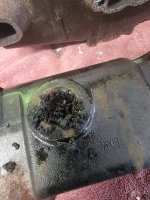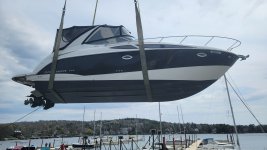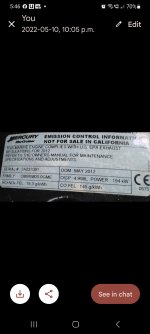Chris Harrington
Recruit
- Joined
- Jun 24, 2023
- Messages
- 5
Hey there, I have twin 5.0 Ltr. mercruisers on my 2013 Bayliner 315 cabin cruiser. I have been chasing an overheating issue since last summer in my port engine. Looking for some ideas as I've tried everything I've heard from experts to forums.
Here are my specs:
Here are my specs:
- Saltwater boat (short season, east coast of Canada)
- 400 hours
- Raw water cooled
- I have done some of the work but I have a very capable mechanic (who is very busy this time of year with our very short season in Nova Scotia).
- Takes the usual 10 minutes to get up to 175F
- Slowly makes it's way up to 200-225 then alarms
- sometimes revving in neural at 2500 rpms will lower the temp but then when at idle temp will rise again.
- Same symptom in the water or on the hard with muffs.
- Run the same tests with idle and rev with the starboard engine and it's fine, hardly goes over 175.
- Oil is clean, no sludge, milk or signs of water.
- Motor runs smooth.
- Very good flow of water coming from my exhaust. Not always hot though. You would think with an engine running 200k and about to alarm would be putting out hot water from the exhaust sometimes it does.....
- Replaced the single point drain (threads broke off at the drain plug, not really relevant but this was about when the heating issue started last summer, adding for sake of details)
- Replaced the thermostat.
- Checked surface temperatures of hoses etc with lazer thermometer to be assured I am actually having high temps and not faulty sensors or guages. Engine is running hot.
- Replaced the raw water pump (pump didn't look to bad but replaced it anyway.
- Replaced riser and elbow gaskets (there was some restriction and thought that was my issue bit no luck)
- Replaced central water pump (didn't look that suspect when took the old one out but replaced with new anyway.
- Removed risers, elbows (again) and took manifolds off this time. Cleaned out bottom of manifolds as they we packed at the 2 bottom cleanouts with a carbon like black material then usual bits of rust I'll add a picture. Got water running much better through all ports with a water hose. Figured this was my fix. Not so
.
- Checked for Bravo-itis. While having the manifolds off we were able to remove and check the bell housing fitting and intake hose that goes to the raw water pump. All clear...
- Tried running with no thermostat also. No difference.
- I have not removed the drive on the port side (the overheating side). Just did some extensive work in the starboard side. Gimble bearing and some shifting work.
Attachments
Last edited:






















